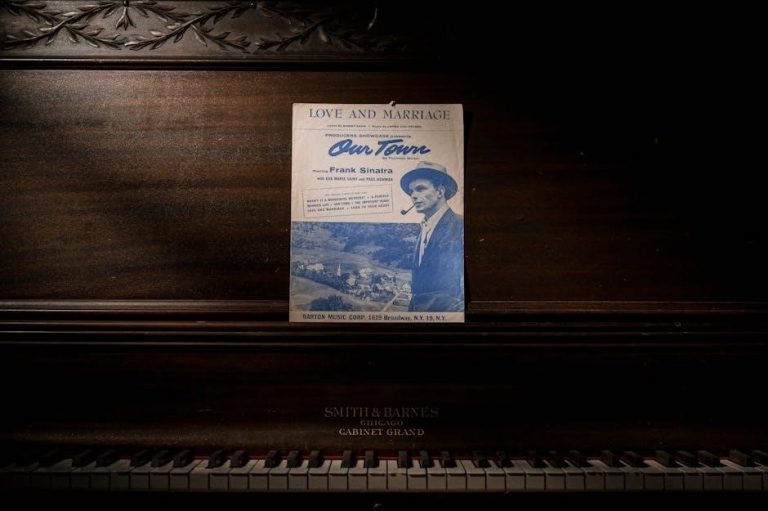
“The Entertainer” by Scott Joplin is a timeless ragtime classic, famously featured in The Sting. This piano sheet music PDF offers a detailed score for pianists to master the piece’s lively rhythms and syncopation, making it an essential resource for both beginners and advanced players.
Overview of the Piece
“The Entertainer,” composed by Scott Joplin in 1902, is a iconic ragtime piece characterized by its lively rhythms and melodic charm. The sheet music features a structured arrangement with multiple themes, showcasing Joplin’s mastery of syncopation and harmonic innovation. Originally published as a piano rag, it gained widespread popularity after its inclusion in the 1973 film The Sting. The piece is celebrated for its technical complexity and emotional depth, making it a staple in the ragtime repertoire. Available in various arrangements, “The Entertainer” caters to pianists of different skill levels, from intermediate to advanced. Its enduring appeal lies in its ability to combine intricate musicality with accessible enjoyment, ensuring its relevance for generations of pianists and music enthusiasts alike.
Importance of Sheet Music in Learning “The Entertainer”
Sheet music is indispensable for mastering “The Entertainer,” as it provides a clear and structured layout of the composition. It ensures pianists accurately interpret Scott Joplin’s intricate rhythms, syncopation, and dynamic markings. The PDF format offers convenience, allowing musicians to access and print the score effortlessly. Having the sheet music enables learners to practice effectively, focusing on maintaining the steady tempo and complex ragtime patterns. It also serves as a reference for understanding the piece’s harmonic progression and melodic phrasing. For pianists of all levels, sheet music is a vital tool for achieving an authentic and polished performance of this timeless ragtime classic.

History and Background of “The Entertainer”
Composed by Scott Joplin in 1902, The Entertainer is a classic ragtime piece that gained widespread popularity after its feature in the 1973 film The Sting.
Scott Joplin and His Contribution to Ragtime
Scott Joplin, often hailed as the “King of Ragtime,” revolutionized American music with his groundbreaking compositions. His iconic piece, The Entertainer, along with works like Maple Leaf Rag and The Sting, elevated ragtime from a regional style to a nationally recognized genre. Joplin’s music seamlessly blended African-American musical traditions with classical forms, creating a unique sound characterized by syncopation, banjo-like rhythms, and harmonic complexity. His contributions not only defined ragtime but also influenced generations of composers, bridging cultural divides and leaving an indelible mark on American musical history. Despite facing career challenges, Joplin’s legacy endures, inspiring musicians and remaining a testament to his innovative spirit.
Composition Year and Original Publication
Scott Joplin composed The Entertainer in 1902, during the height of the ragtime era. Initially published by John Stark & Son, the piece gained moderate success but did not achieve widespread popularity until its inclusion in the 1973 film The Sting, which brought it to a global audience. The original publication featured Joplin’s meticulous notation, emphasizing the importance of maintaining a steady tempo and precise rhythm. The sheet music’s clarity and structure have made it accessible to pianists across various skill levels, ensuring its enduring relevance. Today, The Entertainer remains a cornerstone of ragtime repertoire, celebrated for its lively and intricate composition.
The Role of “The Entertainer” in Popular Culture
The Entertainer gained widespread fame after its inclusion in the 1973 film The Sting, where it became synonymous with the movie’s success, earning an Academy Award for Best Original Song Score. This exposure reintroduced ragtime to a new generation, sparking a revival of interest in Scott Joplin’s work. The piece has since been featured in numerous films, commercials, and media, solidifying its place in pop culture. Its catchy melody and rhythmic complexity make it a favorite for various adaptations and arrangements, further cementing its legacy as an iconic piece of American music. The song’s enduring popularity continues to inspire new interpretations and performances, ensuring its relevance in modern times.

Features of “The Entertainer Piano Sheet Music PDF”
The PDF features Scott Joplin’s original composition, arranged for intermediate pianists, with clear notation and structured format. It includes interactive sheets and is available in free and paid versions.
Structure and Complexity of the Music
Scott Joplin’s “The Entertainer” is a classic ragtime piece with a distinct structure. It features a mix of 2/4 and 3/4 time signatures, creating a unique rhythmic blend. The music is divided into several themes, each with its own character, from the lively introduction to the syncopated main melody. The complexity lies in its intricate rhythms, which require a steady tempo and precise timing. Pianists must master the balance between the syncopated bass lines and the flowing treble melodies. The piece is both technically challenging and musically rewarding, making it a favorite among pianists of all levels. Proper articulation and dynamics are essential to capture the true essence of ragtime.
Different Arrangements and Levels of Difficulty
“The Entertainer” is available in various arrangements to suit pianists of all skill levels. Simplified versions cater to beginners, focusing on the main melody and basic rhythms, while more complex arrangements include intricate harmonies and syncopation for advanced players. Intermediate versions often strike a balance, maintaining the piece’s essence without overwhelming technical demands. Some arrangements, like those by David Bruce or James Brigham, offer a clearer structure for learning. Websites such as 8notes.com and Pianokafe provide graded sheet music, allowing pianists to choose their preferred difficulty level. This versatility ensures that “The Entertainer” remains accessible and engaging for musicians at every stage of their development.
Free vs. Paid Versions of the Sheet Music
Both free and paid versions of “The Entertainer” piano sheet music are widely available online. Free versions, often found on websites like 8notes.com and pianokafe.com, provide basic scores suitable for learning the melody and rhythm. However, these may lack advanced features like interactive tools or detailed annotations. Paid versions, available on platforms such as Musicnotes or Sheet Music Plus, offer higher-quality prints, additional arrangements, and educational resources. Some paid versions include multiple difficulty levels or arrangements, catering to pianists of varying skills. While free versions are ideal for beginners, paid options are recommended for those seeking a more comprehensive and polished learning experience. This dual availability ensures accessibility for all musicians, regardless of their budget or skill level.

Where to Find “The Entertainer Piano Sheet Music PDF”
The Entertainer piano sheet music PDF can be downloaded from websites like pianokafe.com, 8notes.com, and Musicnotes. Both free and paid versions are available for pianists.
Recommended Websites for Downloading
Several websites offer high-quality versions of “The Entertainer” piano sheet music PDF. pianokafe.com provides a free downloadable PDF, ideal for intermediate pianists. 8notes.com offers both free and paid versions, with interactive features for enhanced learning. Musicnotes features professionally arranged sheets, catering to advanced players. Additionally, Sheet Music Plus and Free-Scores provide diverse arrangements, including simplified versions for beginners. These platforms ensure pianists can access reliable, accurate sheet music tailored to their skill levels. Always verify the source’s credibility to ensure quality and accuracy in the scores.
Public Domain Sources and Copyright Information
Scott Joplin’s “The Entertainer,” composed in 1902, is now in the public domain, making the original composition freely accessible. However, specific arrangements or transcriptions of the piece may still be under copyright. Users should verify the licensing terms of any downloaded sheet music to ensure compliance with copyright laws. Reputable sources like public domain libraries or educational websites often provide free access to the original score. Always check the source’s copyright information to avoid infringement. This ensures that pianists can legally enjoy and perform “The Entertainer” while respecting intellectual property rights.
_sites Offering Interactive Sheet Music
Websites like 8notes.com and pianokafe.com provide interactive sheet music for “The Entertainer,” allowing pianists to explore the piece digitally. These platforms often feature MIDI files, enabling users to listen to and play along with the music. Some sites offer adjustable tempos, making it easier for learners to practice complex sections. Additionally, interactive tools may include note-by-note highlighting and playback controls, enhancing the learning experience. These resources are particularly useful for pianists who prefer a digital approach to mastering the piece. Many of these sites also offer free downloads of the PDF sheet music, catering to both traditional and modern learning preferences. This blend of interactivity and accessibility makes them invaluable for pianists of all levels.

Tips for Pianists Learning “The Entertainer”

Tips for Pianists Learning “The Entertainer”
Start with a steady tempo to maintain the ragtime feel. Practice complex sections slowly and gradually increase speed. Use interactive sheet music tools for better understanding and mastery of the piece.
Mastering the Steady Tempo
Mastering the steady tempo in “The Entertainer” is crucial, as ragtime music relies heavily on a consistent rhythmic foundation. Start by practicing at a slower tempo to ensure accuracy, then gradually increase speed. Use a metronome to maintain precision and develop muscle memory. Focus on Scott Joplin’s instruction to “not play fast,” emphasizing a steady, lilting rhythm. Break the piece into smaller sections, perfecting each before combining them. Regular practice will help you achieve a smooth, confident performance. This approach ensures the music’s infectious energy and charm shine through, making it enjoyable for both player and listener.
Understanding Ragtime Rhythms
Understanding ragtime rhythms is essential for playing “The Entertainer” authentically. Ragtime is characterized by its syncopated melodies and steady harmonic rhythms. In “The Entertainer,” Scott Joplin employs a “swing” feel, where the right-hand melody plays off-beat accents against the left-hand’s steady bass. Practice emphasizing the second and third beats in each measure to capture the distinctive ragtime bounce. Pay attention to the sheet music’s articulation marks, such as staccatos and legatos, which shape the rhythmic texture. Listening to recordings of Joplin’s works can also provide valuable insight into the rhythmic nuances. By mastering these elements, pianists can deliver a performance that honors the original intent of the piece while adding their own flair.
Practice Techniques for Complex Sections
Mastering the intricate sections of “The Entertainer” requires focused practice techniques. Begin by breaking down challenging passages into smaller segments, practicing each at a slow tempo before gradually increasing speed. Use a metronome to maintain a steady beat, ensuring precision in syncopated rhythms. Hands-separate practice is crucial for complex fingerwork; once comfortable, combine them smoothly. Pay attention to dynamics and articulation, as marked in the sheet music. For particularly difficult sections, consider using interactive tools or apps to slow down the music without losing pitch. Consistent, patient practice will help build confidence and fluency, allowing you to navigate the piece’s demanding technical requirements with ease and expression.

The Significance of Ragtime Music
Ragtime music, exemplified by The Entertainer, significantly influenced early jazz and American musical culture with its rhythmic complexity and lively spirit, enduring as a popular classic.
Historical Context of Ragtime
Ragtime emerged in the late 19th and early 20th centuries as a unique blend of African-American musical traditions and European classical music. It became a cultural phenomenon, particularly in the United States, with composers like Scott Joplin leading the movement. Joplin’s The Entertainer, composed in 1902, epitomized ragtime’s rhythmic complexity and lively spirit. The genre played a pivotal role in breaking racial barriers in music and paved the way for jazz. Ragtime’s syncopated rhythms and formal structures resonated with audiences, making it a defining sound of the era. Its influence extended beyond music, reflecting the social changes of the time and connecting to the broader cultural movements, including the Harlem Renaissance.
Key Characteristics of Ragtime Composition
Ragtime music is defined by its syncopated rhythms, emphasizing off-beat notes to create a lively, bouncy feel. Compositions like The Entertainer feature a “swing” or “bounce” rhythm, with a steady left-hand accompaniment and a complex right-hand melody. The genre often uses chromaticism and unexpected harmonic shifts, adding richness and complexity; Ragtime typically follows a formal structure, such as binary form, with repeating sections and themes. Its interplay of African-American musical traditions and European classical influences gives it a unique sound. Scott Joplin’s work exemplifies these traits, blending technical precision with emotional depth. The balanced interplay between hands and the rhythmic energy make ragtime a captivating and challenging genre for pianists.
Scott Joplin’s Legacy in Modern Music
Scott Joplin’s compositions, particularly The Entertainer, have left an indelible mark on modern music. His ragtime works influenced early jazz, blues, and even rock musicians. The syncopated rhythms and harmonic complexity in his music inspired generations of composers and performers. Joplin’s revival in the 1970s, thanks to The Sting soundtrack, introduced his music to a new audience; Today, his pieces are adapted and arranged for various instruments, keeping his legacy alive. Joplin’s innovative approach to rhythm and structure continues to inspire contemporary artists, ensuring his place as a foundational figure in American music history.

Resources for Further Learning
Explore tutorials, video lessons, and books to deepen your understanding of The Entertainer. Join piano communities and forums for shared insights and growth as a pianist.
Tutorials and Video Lessons
Mastering The Entertainer is easier with high-quality tutorials and video lessons. Platforms like YouTube offer step-by-step guides, breaking down complex sections into manageable parts. Channels such as Piano Lessons On The Web provide detailed instruction, focusing on ragtime techniques and rhythm. Many pianists also share their interpretations online, offering unique insights. Additionally, websites like Piano Nanny and HDpiano feature interactive lessons, blending visual and auditory learning. These resources are ideal for pianists seeking to refine their skills and understand the nuances of Scott Joplin’s composition. Video lessons are particularly helpful for visual learners, ensuring a deeper grasp of timing and articulation.
Books and Educational Materials
For a deeper understanding of The Entertainer, various books and educational materials are available. These resources often include detailed sheet music, historical context, and performance tips. Many piano method books feature simplified versions of The Entertainer for beginners, while advanced editions offer the original composition. Websites like 8notes.com and pianokafe.com provide downloadable PDFs with annotations and fingerings. Additionally, books on ragtime history, such as Ragtime Piano by Rudi Blesh and Harriet Janis, offer insights into Joplin’s style. Educational materials also include step-by-step guides, practice exercises, and audio recordings. These tools are invaluable for pianists aiming to master The Entertainer and explore ragtime music in depth.
Communities and Forums for Pianists
Pianists learning The Entertainer can benefit from joining online communities and forums dedicated to piano music. Websites like pianokafe.com and 8notes.com offer forums where players can share tips, ask questions, and discuss their progress. Reddit’s r/piano and r/WeAreTheMusicMakers are vibrant communities where musicians exchange insights and advice. Additionally, Facebook groups and Discord servers focused on ragtime or Scott Joplin provide spaces for collaboration and feedback. These platforms are invaluable for connecting with fellow pianists, gaining inspiration, and refining techniques. By engaging with these communities, pianists can enhance their learning experience and gain new perspectives on mastering The Entertainer.

Performance and Interpretation
Performing The Entertainer requires a steady tempo and dynamic contrasts to capture its ragtime essence. Players should emphasize syncopation and articulation, adding personality to make the piece lively and engaging.
Dynamic and Articulation Guidelines
Dynamics and articulation are crucial for capturing the vibrant spirit of The Entertainer. Pianists should emphasize strong contrasts between loud and soft sections to highlight the ragtime character. Staccato notes should be played short and crisp, while legato passages require smooth transitions. The iconic bass lines benefit from a slightly stronger touch to maintain rhythmic clarity. Pay attention to accelerando and ritardando markings, as they add expression to the performance. Syncopated rhythms must be sharp and precise to preserve the piece’s energy. Proper use of dynamics and articulation brings out the playful and sophisticated qualities of Joplin’s composition, making it both engaging and authentic to its ragtime roots.
Ornamentation and Expression
Ornamentation in The Entertainer is key to its ragtime charm. Grace notes, trills, and syncopation add flair, while chromatic embellishments enhance the harmonic richness. Pianists should approach these ornaments with precision, ensuring they complement the piece’s rhythmic vitality. Expression is equally vital; Joplin’s music thrives on dynamic contrasts and phrasing that convey both playfulness and sophistication. Players should experiment with subtle rubato to emphasize melodic lines while maintaining a steady underlying pulse. Listening to recordings of Scott Joplin’s works can provide insights into authentic expression. The sheet music often includes articulation marks, which guide pianists in interpreting the composer’s intent. Balancing technical accuracy with emotional depth ensures a captivating performance of this ragtime classic.
Bringing Personality to the Performance
Pianists can infuse The Entertainer with their unique personality by experimenting with dynamics, phrasing, and emotional expression. While adhering to the ragtime style, subtle variations in tempo and articulation can add a personal touch. Players might emphasize certain melodic motifs or rhythmic patterns to highlight their interpretation. Scott Joplin’s music, while structured, allows for spontaneity, enabling performers to connect deeply with the piece. By exploring different expressive nuances, pianists can make the performance distinctly their own while honoring the composer’s intent. This approach not only showcases technical skill but also shares the artist’s individuality, making each rendition of The Entertainer a fresh and engaging experience for listeners.
“The Entertainer” remains a timeless classic, offering pianists a chance to explore ragtime’s vibrant rhythms. Its availability as a PDF ensures accessibility for musicians of all levels, fostering inspiration and enjoyment through its enduring charm.
Final Thoughts on “The Entertainer”
“The Entertainer” is a cornerstone of ragtime music, with its PDF sheet music serving as a gateway to Scott Joplin’s genius. This piece, composed in 1902, has transcended generations, gaining renewed popularity through its feature in The Sting. The availability of free and paid PDF versions, including simplified arrangements, makes it accessible to pianists of all skill levels. Whether for learning or performance, “The Entertainer” offers a rich musical experience, blending complexity with catchy melodies. Its enduring appeal lies in its ability to challenge and inspire, ensuring its place as a beloved classic in piano repertoire.

Encouragement for Aspiring Pianists
Embarking on “The Entertainer” is a rewarding journey for pianists at any stage. Beginners can start with simplified versions, gradually building confidence, while more advanced players can explore intricate arrangements. The steady tempo and syncopated rhythms offer a chance to refine technique and musicality. Embrace challenges as opportunities to grow, and remember that practice is key to mastery. Scott Joplin’s legacy invites pianists to connect with ragtime’s rich history, making “The Entertainer” a fulfilling and enjoyable piece to learn and perform. With persistence and passion, every pianist can bring this iconic composition to life, sharing its vibrant spirit with audiences worldwide.
